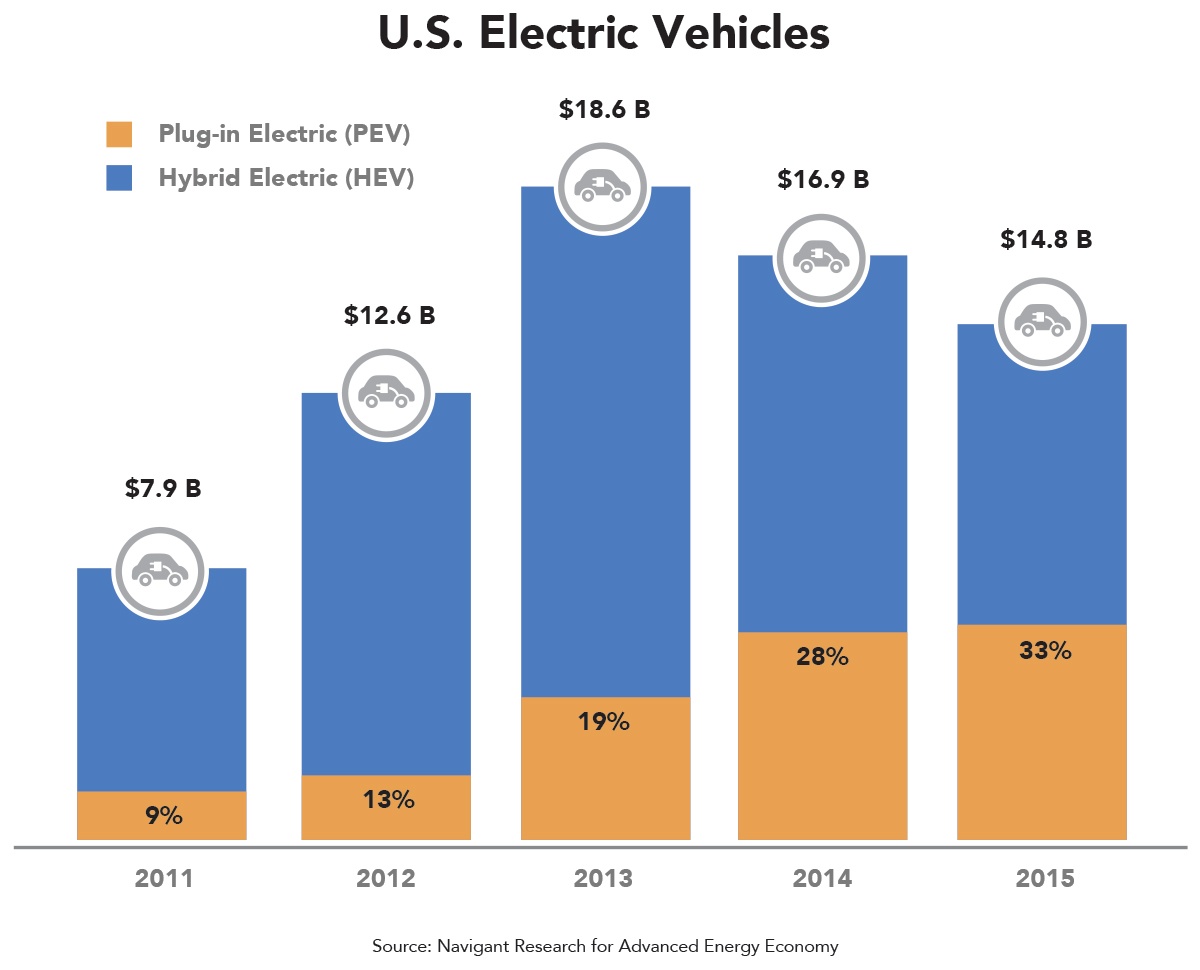This post is one in a series of feature stories on trends shaping advanced energy markets in the U.S. and around the world, drawn from Advanced Energy Now 2016 Market Report, which was prepared for AEE by Navigant Research.

Despite lower prices at the gas pump, the prospects for EVs continue to be bright, in large part due to remarkable advances in EV storage technology. Early hybrid vehicles almost exclusively featured nickel-metal hydride (NiMH) batteries. Now, lithium ion (Li-ion) has taken over the hybrid sector, and dominates the Plug-in Hybrid Electric Vehicle (PHEV) and Battery Electric Vehicle (BEV) markets as well. Most new production hybrids, apart from the Toyota Prius, and all PHEVs and BEVs in 2015 were shipped with Li-ion batteries. While new battery chemistries are now being tested, and could make their way into market in the coming years, the focus through the early 2020s will remain on further lowering costs and improving the energy density (and resulting vehicle range) of Li-ion batteries.
While the market for Li-ion batteries for vehicle electrification is still developing, several companies have emerged as leaders. The most successful Li-ion battery manufacturers to date (LG Chem, Panasonic, Samsung SDI) are large and financially stable companies or their subsidiaries. These leaders provide Li-ion batteries to multiple markets, such as the consumer electronics and emerging stationary grid energy storage markets. But in the United States, Tesla Motors made news with its battery “gigafactory,” now under construction in Nevada, and its claims that, without it, the company might not be able to source enough batteries for its BEVs and new Powerwall home energy storage product.
When designing electric or electrically assisted powertrains, automakers continue to tailor their design approach to each model, factoring in not only economy, but also power, energy, and range performance. Luxury brands have begun to focus on meeting the driver experience and vehicle performance bar that has been set in the BEV sector by Tesla’s Model S.
Navigant Research expects two distinct BEV market segments to emerge and mature over the next five years: a large capacity sector, often with premium vehicles, with larger energy capacities and longer-range battery packs, and a second segment with lower capacity, shorter range, and a lower-cost class of battery packs geared for local driving and daily commutes.
Original equipment manufacturers (OEMs) have continued their efforts to improve the supply chain cost structure for battery manufacturers with consistent battery performance standards. They are also taking advantage of a maturing supply chain and manufacturing capacity gains to help reduce costs. But vehicle manufacturers continue to require unique battery pack specifications, challenging the gains made to date from supply chain efficiencies. Lower battery costs for the industry during the next decade will likely remain a function of manufacturing and supply chain efficiencies and incremental chemistry improvements rather than new chemistries, as any breakthroughs in energy or power density are likely to be tested for several years before an automaker incorporates them into a vehicle.
Revenue from sales of battery packs to auto manufacturers rose 14% globally, to $6.3 billion, from 2014 to 2015. That total was seven-and-a-half times the battery-pack revenue of $824 million in 2011. In the United States, battery pack revenue fell 17% in 2015, to $1.4 billion, due to declining sales of HEVs, but was still five times 2011 revenue of $271 million.
The global market for Li-ion batteries for HEVs and PEVs in automotive applications is expected to grow at a 2015-2020 compound annual growth rate (CAGR) of 32% in energy capacity, to 61.3 GWh. The majority (72%) of demand for Li-ion EV batteries will come from BEVs due to the larger battery packs typical of those vehicle types.
Learn more about the advanced vehicle market in Advanced Energy Now 2016 Market Report, available for free at the link below.
